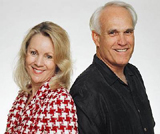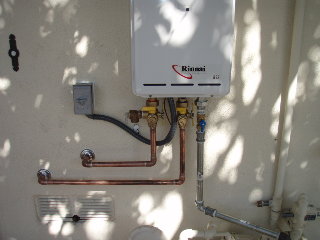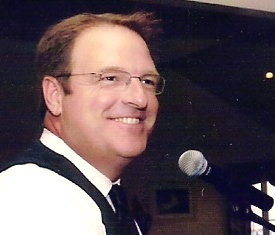(March 1, 2007) -- As previously reported by LBReport.com, State Sen. Lowenthal (D., LB-SP-PV) has introduced new legislation, described by his office in a press release as a "Port Investment Bill," that differs significantly from a container fee measure that he previously authored and Governor Schwarzenegger vetoed in 2006.
LBReport.com posts salient portions of the "Port Investment Bill" text below.
Sen. Lowenthal's 2006 container fee bill proposed three uses for the container fee revenue: clean air projects decided by the SCAQMD (later changed to CA Air Resources Board); port rail projects and homeland security. The 2007 version relegates SCAQMD to a consultative role in preparing a "list of projects that reduce air pollution" which "shall be consistent with" an April 2006 Emission reduction Plan and "designed to reduce air pollution...in order to reach federal air quality attainment standards and to meet the ERP's goals for 2010, 2015, and 2020."
In developing the list, the state Air Resources Board [the agency which entered into an MOU with CA RRs opposed by SCAQMD] is required to "consult" with SCAQMD along with the Gateway Council of Governments (in which the Ports of LB and L.A. are members) and separately with the Ports of LB and L.A.
The bill requires the state Air Resources Board to work with SCAQMD as well as the Ports of LB and L.A. "to ensure that projects within the San Pedro Bay Clean Air Action Plan are completed or implemented. The board may provide funding to the district or the ports in order to achieve the goals of the plan."
The legislation no longer proposes funding homeland security items [port-industry interests opposed paying for homeland security at a state level, contending it's a federal matter. Meanwhile at the federal level, the American Ass'n of Port Authorities has opposed paying port-user fees for homeland security.]
The "Port Investment Bill" (SB 974) isn't accompanied by "no net increase" legislation that Sen. Lowenthal said as recently as 2006 was necessary to provide a legally enforceable guarantee that new infrastructure and port growth won't worsen levels of port-related pollutants.
The "Port Investment Bill" declares (text below) that the legislature finds that cleaner air will result as a by-product of port infrastructure development that promotes greater efficiency in cargo movement. This theory, commonly called "cleaner air, faster freight," is supported by Port-related interests that seek government-provided capacity expansion.
Critics say this plausible sounding assumption isn't sufficiently proven and doesn't factor-in the net result of growth invited by the new infrastructure. (A "plan" to reduce pollution from a source by [figures for illustration only] 50% while new infrastructure invites the "reduced" source to double (increase by 100%) means more net pollution, not less.)
Although the new infrastructure and its effects would be permanent, clean air "plans" are subject to being changed, eased, waived or deemed infeasible by government agencies or legislative bodies.
Officials of the Ports of LB and L.A. have publicly indicated that they consider their "Clean Air Action Plan" an evolving document and is subject to being changed or revised.
As recently as July 2006 (as previously reported by LBReport.com), Senator Lowenthal testified that "no net increase" legislation was needed to ensure enforceable results from the LB/LA Ports' "Clean Air Action Plan." In contrast, Sen. Lowenthal's 2007 "Port Investment Bill" turns the process around, citing the LB/LA Ports' non-binding "Clean Air Action Plan" as a goal for new port infrastructure that his legislation would fund.
In response to an inquiry from LBReport.com asking why Senator Lowenthal hadn't reintroduced "no net increase" legislation by the Feb. 23 2007 Senate session, his office responded with the following statement by the Senator:
Senator Lowenthal Feb. 27 statement: While I believe the original goals of my "no net increase" bill were laudable at the time, I no longer believe it is sufficient; we need to go further than maintaining the status quo.
As Chair of the Senate Transportation and Housing Committee and as the author of the bills that will implement the goods movement and emissions improvement portion of Proposition 1B, SB 9 and SB 19, I fully intend to include accountability measures in these bills that will require reductions in all types of harmful emissions.
I felt, after long deliberation, that a re-introduction of a "no net increase" bill would set conflicting standards as we try to achieve accountable, measurable reductions in pollution related to port activities.
I remain more committed than ever to holding the ports accountable in regards to reducing harmful emissions related to goods movement.
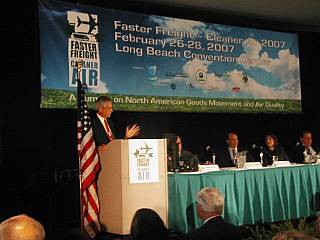 Speaking at a February 28 industry conference ("Faster Freight, Cleaner Air") in LB, Senator Lowenthal indicated that he re-wrote his 2006 container fee measure (which cleared the legislature but was vetoed by the Governor) to address concerns expressed by Governor Schwarzenegger's office.
Speaking at a February 28 industry conference ("Faster Freight, Cleaner Air") in LB, Senator Lowenthal indicated that he re-wrote his 2006 container fee measure (which cleared the legislature but was vetoed by the Governor) to address concerns expressed by Governor Schwarzenegger's office.
In August 2006, members of the Assembly Democrats' leadership blocked Sen. Lowenthal's "no net increase" bill from advancing. The Port of LB said it was neutral on the bill, although the legislation was opposed by the CA Ass'n of Port Authorities (in which the Ports of LB and L.A. are both members and pay dues). The CA and LB Area Chambers of Commerce and a number of port related interests also opposed the "no net increase" legislation.
LBReport.com posts extended portions of SB 974, Sen. Lowenthal's "Port Investment Bill," below:
The bill's findings and declarations state:
(a) There is a need to mitigate the enormous burden imposed on the
highway transportation system serving the Ports of Los Angeles, Long
Beach, and Oakland by the overland movement of cargo shipped from
and to those ports.
(b) The operation of the ports causes environmental pollution that
requires mitigation.
(c) The improvement of goods movement infrastructure would benefit
the owners of container cargo moving through the ports by allowing
the owners of the cargo to move container cargo more efficiently and
to move more cargo through those ports.
(d) The reduction of goods movement pollution would benefit the
owners of container cargo moving through the ports by meeting federal
air quality standards, which will allow for continued federal
funding of goods movement infrastructure projects.
(e) Accordingly, it is the intent of the Legislature to alleviate
these burdens by imposing a fee on shipping containers processed
through those ports and using the funds derived from that fee to do
both of the following:
(1) Improve the rail system that serves as an alternative to
shipping on the highway by commercial vehicle, including, but not
limited to, the ondock rail facilities at those ports.
(2) Mitigate the environmental pollution caused by port
operations.
In its section on "Congestion Relief and Mitigation Relief Projects,"
the bill states in pertinent part:
1750. (a) Beginning January 1, 2008, the commission
[CA Transportation Commission] shall develop a list of projects
that would improve the overall efficiency of container cargo movement
to and from the Ports of Los Angeles and Long Beach by improving
the rail system and container transportation systems that transport
container cargo from and to those ports and
the ondock rail facilities at those ports. In the process for
selecting projects, the commission shall consult with the
transportation commissions for the Counties of Los Angeles, Orange,
Riverside, San Bernardino, and Ventura, the Port of Los Angeles,
the City of Los Angeles, the Port of Long Beach, the City of Long Beach,
and the Southern California Association of Governments. The commission
shall hold public hearings to seek further input on developing these
projects.
(b) No later than September 1, 2008, the commission, at a public
hearing, shall finalize a list of projects that would improve the
overall efficiency of container cargo movement to and from the Ports
of Los Angeles and Long Beach by improving the rail system and
container transportation systems that transport container cargo from
and to those ports and the ondock rail facilities at those ports.
This will be the final list, of infrastructure projects at the Ports
of Los Angeles and Long Beach, eligible to be funded by the user fee
authorized pursuant to this chapter.
(c) Projects eligible to be on the final list shall not be used to
construct, maintain, or improve highways, unless the highway or road
improvement is part of a rail grade separation, or the highway
improvement is done to separate container cargo from motor vehicle
traffic by creating on-ramps or off-ramps for port container truck
traffic.
(d) In awarding funds pursuant to this section, the commission
shall give priority to those projects that have been designed to
measurably reduce air pollution and environmental impacts to local
communities, to assist in attaining state and federal air quality
goals and enhance environmental performance while addressing the
overall efficiency of container cargo movement.
(e) For all construction projects funded pursuant to this section,
a contractor shall ensure that all mobile nonroad equipment used on
the project will be equipped with a California Air Resources Board
(CARB) verified diesel particulate filter that obtains at least an
85-percent reduction in emissions, unless any of the following
circumstances exists, and the contractor is able to provide proof
that any of these circumstances exists:
(1) A piece of specialized equipment is unavailable in a
controlled form within the state, including through a leasing
arrangement.
(2) A contractor has applied for incentive funds to put controls
on a piece of uncontrolled equipment planned for use on the project,
but the application is not yet approved, or the application has been
approved, but funds are not yet available.
(3) A contractor has ordered a control device for a piece of
equipment planned for use on the project, or has ordered a new piece
of controlled equipment to replace the uncontrolled equipment, but
that order has not been completed by the manufacturer or dealer, and
the contractor has attempted to lease controlled equipment, but no
dealer within 200 miles of the project has the controlled equipment
available for lease.
(f) Projects eligible to be considered by the commission include,
but are not limited to, all of the following:
(1) A project to separate at-grade crossings to reduce conflicts
between trains and motor vehicles in Los Angeles, Orange, Riverside,
and San Bernardino Counties, also known as the Alameda Corridor East
Project.
(2) A project to improve rail capacity by adding additional tracks
to existing rail lines in Los Angeles, Orange, Riverside, and San
Bernardino Counties.
(3) A project to separate at-grade rail crossings in San
Bernardino County, also known as the Colton crossing.
(4) A project to improve ondock rail infrastructure at the Ports
of Los Angeles and Long Beach.
(g) In determining which projects to select, the commission shall
also take into account the entire rail and trade corridor servicing
the Ports of Los Angeles and Long Beach.
(h) The commission shall only use the funds received from the
Southern California Congestion Fund to fund projects authorized
pursuant to this section.
(i) Once the projects on the final list are completed and fully
funded, the commission shall notify the Ports of Los Angeles and Long
Beach that the infrastructure projects are completed and to no
longer collect the one-half of the user fee for infrastructure
projects. The commission may also make a finding that a project on
the final list has either been funded by another source or is no
longer worthy of funding...
1752. (a) Beginning January 1, 2008, the board
[CA Air Resources Board] shall develop a list of projects that
reduce air pollution caused by the movement of container cargo
to and from the Ports of Los Angeles and Long Beach.
The projects on the list shall be consistent with the Emission
Reduction Plan (ERP) adopted April 2006, and shall be designed to
reduce air pollution at those ports in order to reach federal air
quality attainment standards and to meet the ERP's goals for 2010,
2015, and 2020. In developing the list, the board shall consult with
the South Coast Air Quality Management District, the Gateway Council
of Governments, and the Ports of Los Angeles and Long Beach.
(b) The board shall work with the South Coast Air Quality
Management District, the Port of Long Beach, and the Port of Los
Angeles in order to ensure that projects within the San Pedro Bay
Clean Air Action Plan are completed or implemented. The board may
provide funding to the district or the ports in order to achieve the
goals of the plan.
(c) No later than September 1, 2008, the board, at a public
hearing, shall finalize a list of projects that meet the ERP's goals
for 2010, 2015, and 2020, in order to meet federal air quality
attainment standards.
(d) The board may determine, at a public hearing, that the
emission reduction goals for 2020 have been met or exceeded and that
federal air quality standards have been met in the South Coast Air
Basin, and once the determination is made, and ensuring that all
approved projects have been funded, the board shall notify the Port
of Los Angeles of this determination, and the Port of Los Angeles
shall no longer collect the one-half of the user fee for air quality
projects meant to reach these goals and federal air quality
attainment standards.
(e) The board may determine, at a public hearing, that the
emission reduction goals for 2020 have been met or exceeded and that
federal air quality standards have been met in the South Coast Air
Basin, and once the determination is made, and ensuring that all
approved projects have been funded, the board shall notify the Port
of Long Beach of this determination, and the Port of Long Beach shall
no longer collect the one-half of the user fee for air quality
projects meant to reach these goals and federal air quality
attainment standards.
(f) The board shall only use the funds received from the Southern
California Mitigation Fund to fund projects authorized pursuant to
this section...
SEC. 4. Section 1760 of the Harbors and Navigation Code is amended
and renumbered to read:
1760. 1730. (a) For purposes of
this section, "council" means the California Marine and Intermodal
Transportation System Advisory Council, a regional subunit of the
Marine Transportation System National Advisory Council chartered by
the federal Secretary of Transportation under the Federal Advisory
Council Act (P.L. 92-463).
(b) The council is requested to do all of the following:
(1) Meet, hold public hearings, and compile data on issues that
include, but need not be limited to, all of the following:
(A) The projected growth of each maritime port in the state.
(B) The costs and benefits of developing a coordinated state
program to obtain federal funding for maritime port growth, security,
and congestion relief.
(C) Impacts of maritime port growth on the state's transportation
system.
(D) Air pollution caused by movement of goods through the state's
maritime ports, and proposed methods of mitigating or alleviating
that pollution.
(E) Maritime port security, including, but not limited to,
training, readiness, certification of port personnel, exercise
planning and conduct, and critical marine transportation system
infrastructure protection.
(F) A statewide plan for continuing operation of maritime ports in
cooperation with the United States Coast Guard, the federal
Department of Homeland Security, the Office of Emergency Services,
the state Office of Homeland Security, and the California National
Guard, consistent with the state's emergency management system and
the national emergency management system, in the event of a major
incident or disruption of port operations in one or more of the state'
s maritime ports.
(G) State marine transportation policy, legislation, and planning;
regional infrastructure project funding; competitiveness;
environmental impacts; port safety and security; and any other
matters affecting the marine transportation system of the United
States within, or affecting, the state.
(2) Identify all state agencies that are involved with the
development, planning, or coordination of maritime ports in the
state.
(3) Identify other states that have a statewide port master plan
and determine whether that plan has assisted those states in
improving their maritime ports.
(4) Compile all information obtained pursuant to paragraphs (1) to
(3), inclusive, and submit its findings in a report to the
Legislature not later than January 1, 2006. The report should
include, but need not be limited to, recommendations on methods to
better manage the growth of maritime ports and address the
environmental impacts of moving goods through those ports.
(c) The activities of the council pursuant to this section shall
not be funded with appropriations from the General Fund.



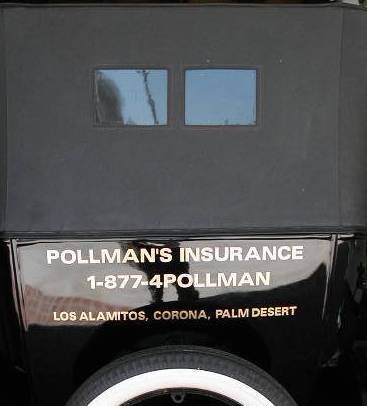

 Speaking at a February 28 industry conference ("Faster Freight, Cleaner Air") in LB, Senator Lowenthal indicated that he re-wrote his 2006 container fee measure (which cleared the legislature but was vetoed by the Governor) to address concerns expressed by Governor Schwarzenegger's office.
Speaking at a February 28 industry conference ("Faster Freight, Cleaner Air") in LB, Senator Lowenthal indicated that he re-wrote his 2006 container fee measure (which cleared the legislature but was vetoed by the Governor) to address concerns expressed by Governor Schwarzenegger's office.
